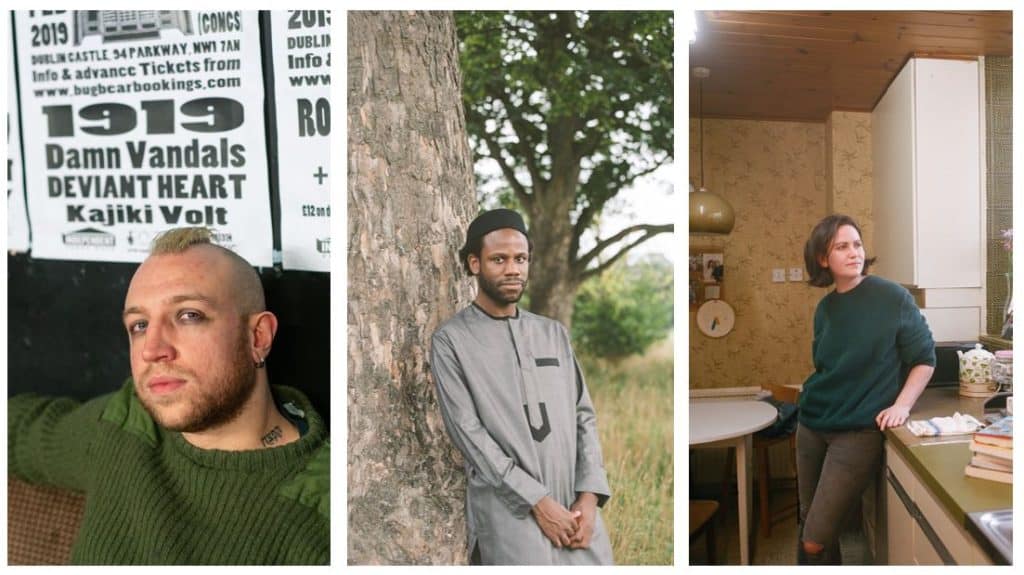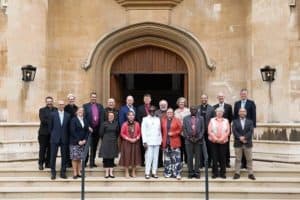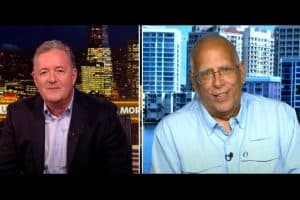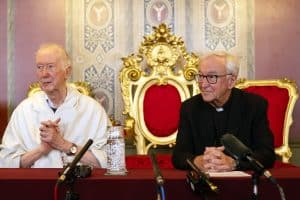Two Haredi men were engaged in conversation as they strolled through Stamford Hill, north London, in January 2015.
That moment was frozen in time by a photographer who snapped their image from behind, to illustrate the headline news that police had increased their presence in Jewish neighbourhoods after the Paris terrorist attack on the Charlie Hebdo newspaper offices and a kosher supermarket that left 12 dead.
If you didn’t see the picture at the time, there’s every chance you might have come across it since. The black-hatted pair have illustrated a gamut of articles about Britain’s Jewish community – regardless of whether or not the Haredi community was affected.
In 2016, CNN featured it in a piece about the UK’s adoption of the international definition of antisemitism. The Guardian added it to a report about a woman who alleged discrimination after being turned away by a housing charity. Local news site MyLondon displayed it under the headline: “Car driver shouts ‘heil Hitler’ at ‘traumatised’ Jewish pedestrian in North London”.
“Once you notice it, it’s hard to unnotice,” says Keith Kahn-Harris, author of the newly published book What Does a Jew Look Like?
It was about five or six years ago when Kahn-Harris, a writer and sociologist, noticed the “ubiquitous” nature of the stock photograph, owned by Getty Images.
A significant part of the problem, he found, was the internet. In the book’s introduction, he explains: “When newspapers began to be published online as fast as possible, editorial staff have had to draw on sources other than specially commissioned photographs to find appropriate images — with little time to reflect on their choice.”
The picture, he says, has now been used by the British media dozens — if not hundreds — of times to illustrate stories about Jews. He writes: “Along with a few other similar photographs also showing black-hatted men with their backs to the camera, it has become the image of Jews in this country.”
The prolific use of this image struck Kahn-Harris as highly problematic, particularly “where it isn’t actually appropriate to use images of Haredis – where the story concerns something that doesn’t apply to them”.
One such example is an article posted by The Spectator in 2017, under the headline: “Jewish students are turning their backs on British universities. Who can blame them?” The piece was a commentary on the rise of antisemitism on campuses that had left Jewish students feeling threatened.
“Very, very few Haredi Jews go to university and there’s quite a lot of strong cultural barriers to doing so in the community,” Kahn-Harris told the Religion Media Centre.
The picture was taken by a freelance photographer, Robert Stothard, who then worked for organisations such as Getty, The Times and The New York Times. Kahn-Harris decided to track him down.
“He had also spotted the ubiquity of the picture and was uncomfortable about it,” Kahn-Harris said.
The pair have spent the past three years working together on the book, which Stothard describes as an “antidote” to the overused 2015 stock image. The slick collection, published this month by Five Leaves Publications, comprises the portraits and stories of 29 individuals living in Britain who identify as Jewish. Listed under their first names only, each tells their story in their own words, alongside a portrait by Stothard.
In a fascinating attempt to highlight the diversity of Britain’s Jewish community, the collection includes – among others – a transgender rabbi, a repeat offender, an Australian-born Yiddish lecturer and a black Jewish man of Nigerian descent.
Kahn-Harris said: “It isn’t intended to be a replacement set of stock photos, rather it’s an educational project and I hope one that has some aesthetic value, just to make a very simple point that should be obvious: that Jews do not all look the same or think the same and are very different from each other.”
Stothard’s beautiful shots include one of a tattooed musician, Rio, against a backdrop of posters for his post-punk band 1919, and another of a rabbi, Yechezkel, who grew up in the Swiss Alps.
Since taking the Stamford Hill image, Stothard, who is not Jewish, has retrained as a secondary school maths teacher. The way that image — and others like it including some of an Islamic celebration — was taken out of its editorial context contributed to the move.
He said: “When Keith contacted me, I wasn’t surprised or shocked. Somebody was asking the questions and I was quite pleased to speak about it. My frustrations in working in that part of news had been building. It’s around narratives, dissemination and controlling stories.”
His photographic interest lies in storytelling, something he feels he has effectively done with this collection. “I love images where there are layers to them and you don’t just look at the person,” he said.
“That’s what is so special about the book: everyone in it has layers to their personality and we were trying to show diversity within the Jewish community. It isn’t necessarily about their link to Judaism but all the other things that make them unique as well.”
Robert Stothard and Kahn-Harris will be discussing their book at a launch event at JW3 on Monday 11 April. They will joined by Fiona Shields, head of photography at The Guardian, and Rabbi Frank Dabba Smith, who has worked as a professional photographer for The Economist


















